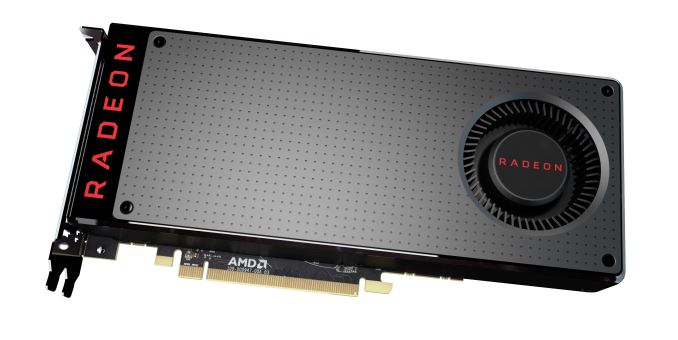The AMD Radeon RX 480 Preview: Polaris Makes Its Mainstream Mark
by Ryan Smith on June 29, 2016 9:00 AM ESTFirst Thoughts
Bringing our first look at AMD’s new architecture to a close, it’s exciting to see the field shape up for the FinFET generation. After over four years since the last great node transition, we once again are making a very welcome jump to a new manufacturing process, bringing us AMD’s Polaris.
AMD learned a lot from the 28nm generation – and more often than not the hard way – and they have put those lessons to good use in Polaris. Polaris’s power efficiency has been greatly increased thanks to a combination of GlobalFoundries 14nm FinFET process and AMD’s own design choices, and as a result, compared to AMD’s last-generation parts, Polaris makes significant strides where it needs to. And this goes not just for energy efficiency, but overall performance/resource efficiency as well.
Because AMD is launching with a mainstream part first they don’t get to claim to be charting any new territory on absolute performance. But by being the first vendor to address the mainstream market with a FinFET-based GPU, AMD gets the honor of redefining the price, performance, and power expectations of this market. And the end result is better performance – sometimes remarkably so – for this high volume market.
Relative to last-generation mainstream cards like the GTX 960 or the Radeon R9 380, with the Radeon RX 480 we’re looking at performance gains anywhere between 45% and 70%, depending on the card, the games, and the memory configuration. As the mainstream market was last refreshed less than 18 months ago, the RX 480 generally isn’t enough to justify an upgrade. However if we extend the window out to cards 2+ years old to things like the Radeon R9 280 and GeForce GTX 760, then we have a generational update and then-some. AMD Pitcairn users (Radeon HD 7800, R9 270) should be especially pleased with the progress AMD has made from one mainstream GPU to the next.
Looking at the overall performance picture, averaged across all of our games, the RX 480 lands a couple of percent ahead of NVIDIA’s popular GTX 970, and similarly ahead of AMD’s own Radeon R9 390, which is consistent with our performance expectations based on AMD’s earlier hints. RX 480 can't touch GTX 1070, which is some 50% faster, but then it's 67% more expensive as well.
Given the 970/390 similarities, from a price perspective this means that 970/390 performance has come down by around $90 since these cards were launched, from $329 to $239 for the more powerful RX 480 8GB, or $199 when it comes to 4GB cards. In the case of the AMD card power consumption is also down immensely as well, in essence offering Hawaii-like performance at around half of the power. However against the GTX 970 power consumption is a bit more of a mixed bag – power consumption is closer than I would have expected under Crysis 3 – and this is something to further address in our full review.
Finally, when it comes to the two different memory capacities of the RX 480, for the moment I’m leaning strongly towards the 8GB card. Though the $40 price increase represents a 20% price premium, history has shown that when mainstream cards launch at multiple capacities, the smaller capacity cards tend to struggle far sooner than their larger counterparts. In that respect the 8GB RX 480 is far more likely to remain useful a couple of years down the road, making it a better long-term investment.
Wrapping things up then, today’s launch of the Radeon RX 480 puts AMD in a good position. They have the mainstream market to themselves, and RX 480 is a strong showing for their new Polaris architecture. AMD will have to fend off NVIDIA at some point, but for now they can sit back and enjoy another successful launch.
Meanwhile we’ll be back in a few days with our full review of the RX 480, so be sure to stay tuned.











449 Comments
View All Comments
carex - Wednesday, July 6, 2016 - link
where is 970 in the Battlefield 4 bench?fxv300 - Thursday, July 7, 2016 - link
Got mine yesterday and installed it.Tried it using Astra 28.2 Freesat transmission 4K @ 50 Fps
https://youtu.be/4r8lUJGZT84
you can see all the sensors and gpu power usage.
All good so far
Oxford Guy - Friday, July 8, 2016 - link
"The $199 price tag means that AMD can’t implement any exotic cooling or noise reduction technologies, though strictly speaking it doesn’t need them"1) Dual fan open air coolers are hardly "exotic".
2) It does need them. 50 dB is awful.
k3rast4se - Monday, July 11, 2016 - link
I've created at petition regarding the lack of review on anandtech.com. Basically we are just asking for an explanation on the situation as there might be genuine reason for this. Please support this!https://twitter.com/k3rast4se/status/7525464697317...
SaolDan - Thursday, July 14, 2016 - link
You must be joking. Ryan or any of the other writers dont owe you any explations at all. Get a life dude.isik - Tuesday, July 12, 2016 - link
www.egemenweb.com thankscarex - Tuesday, July 19, 2016 - link
what cheating seriously 970 completely removed from the Battlefield 4 bench against 480 and they didnt test the vulkan at all must have been paid by nvidiamikato - Friday, July 29, 2016 - link
Radeon HD 6950 (unlocked to mostly 6970) here. I think it may be a good time for an upgrade finally :) The price is right!Olegendary - Wednesday, September 7, 2016 - link
Sorry for out of topic comment but need your help, would anyone suggest the radeon RX 480 but for CPUs. RxX 480 seems to be a candy for that price but i don't know any cpu which is powerful and cheap (well 200$ isn't cheap but u know what i mean) thanks